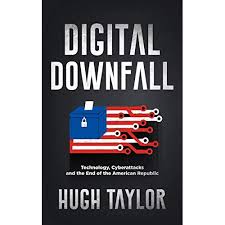Can you lose a war you do not even know you are fighting? That is the fundamental question Hugh Taylor askes of the United States in his book Digital Downfall. After reviewing a simplified history of computing, the internet of things (IoTs), and open-source programming, the book discusses on-going Russian and Chinese attacks across American government, military, and corporations. It concludes with the risks we face from bearing the brunt of these continued attacks and implores the United States collectively to take tangible steps for better current and future protection. While the reader may be tempted to brush these off as “America’s problems”, it is incredibly easy to find relatable current events in Australia. I had to look no further than my twitter feed to find the Minister of Defence tweeting about “Boosting Australia’s cyber resilience” as I read the book.
Taylor annotates Russia’s strategy of waging a “hybrid war”, defined as “attacking an adversary while remaining just under the threshold of conventional war”. This is also commonly referred to as grey zone competition, fighting between the threshold of peace and war. Russia’s dezinformatsiya campaign is focused on “filling information with misinformation” in order to destroy “important pillars of Western society”. Digital Downfall outlines examples of Russian ransomware, data breaches, disinformation campaigns, and “cyber physical” attacks and how the combination of these efforts leads to their strategic intent. An example I found particularly interesting in this section detailed two opposing Russian-controlled Facebook groups, ‘Heart of Texas’ and ‘United Muslims of America’. ‘Heart of Texas’ scheduled a rally, ‘Stop Islamification of Texas’, for 21 May 2016 on Travis Street in downtown Houston. On the same day and location, ‘United Muslims of America’ planned a ‘Save Islamic Knowledge’ event. 9,000 kilometers away, Russian operatives intentionally created a protest/counter-protest situation from the convenience of their computers and verbal altercations ensued between Americans in Houston. It is not far from the possible that physical violence could stem from these situations brewed all the way in Russia; this was just one simple example of Russia trying to break down the pillars of Western society.
Juxtaposing the Russian techniques, the Chinese strategy to gain global power across all dimensions – economically, militarily, technologically, and diplomatically – is occurring much more discreetly. The Chinese Communist Party’s (CCP) cyber initiatives are one facet of their ‘unrestricted war’ against the United States; Taylor writes the CCP knows the United States is their largest threat to becoming the global economic and military leader it strives to be. Through a combination of theft of consumer data, theft of corporate intellectual property, theft of government data, theft of military data, and embedding malware into Chinese-made technology, the CCP is exercising their cyber dominance to US detriment. Digital Downfall discusses the US Office of Personnel Management (OPM) breach of 22 million confidential personnel records, including security clearance data and finger prints, attributed to a Chinese hack. This data, combined with other corporate data hacks, is likely being used to build a database on US government officials for ease of blackmail efforts in China’s favor. The fact that China’s hack of defence contractors in 2007 resulted in the theft of the F-35 fighter jet plans should be of particular interest to any Australian Defence Force (ADF) member as the Royal Australian Air Force continues to receive their acquisition of 72 F-35 Lightening IIs.
This is not just happening to America. In June 2019, China stole 19 years’ worth of data from students and staff from Australia National University. In March 2020, an ADF recruiting database “was shut down for 10 days due to fears it had been hacked”. In June 2020, personal security cameras of Australian citizens were hacked and streamed on a Russian-based website. It is no surprise that $15 billion is being invested in the information and cyber sector as a part of the 2020 Defence Strategic Update. Hugh Taylor simply and straightforwardly outlines the basics of what will be a complex arm of future warfare. I would recommend reading Digital Downfall to anyone looking to gain a basis of knowledge as we continue to wade into and be victims of the uncertain cyber campaigns of grey zone competition.
About the Author:
Darby Nelson is a Marine Corps Supply Officer stationed in Okinawa, Japan. She has a strong interest in the quest to be both smart and strong. She also has a fascination with the Australian Army. You can follow her on twitter @darbyanelson

